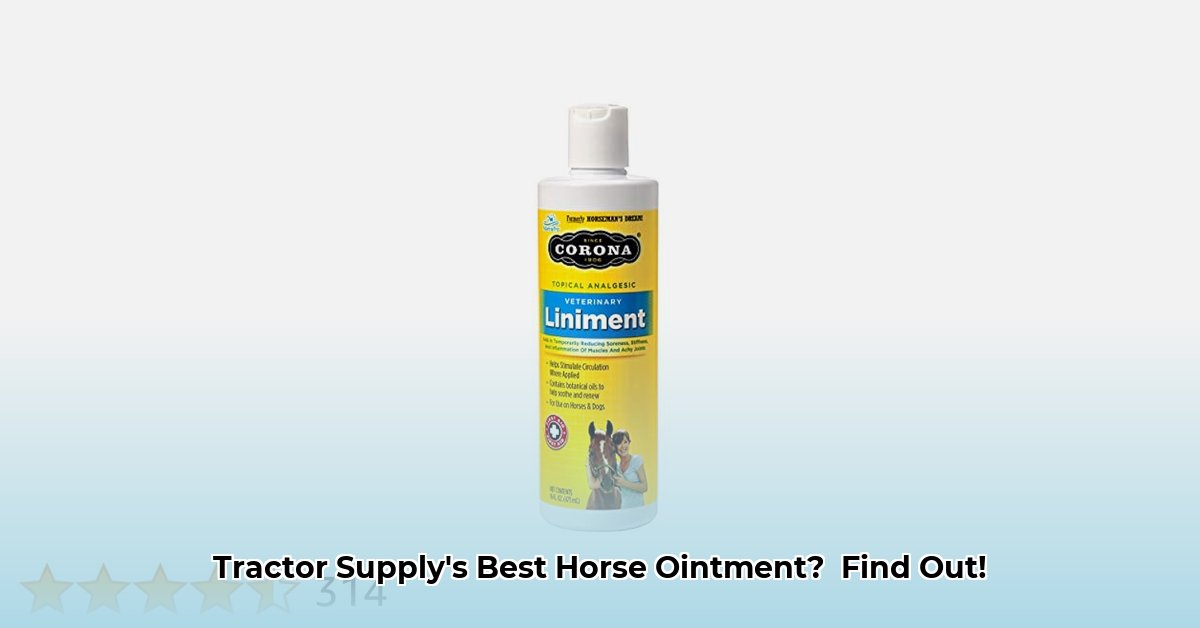
Choosing the right horse ointment can significantly impact your horse's health and well-being. This guide helps you navigate the options available at Tractor Supply, focusing on effective treatment and sustainable practices. For additional cleaning supplies, check out our horse shampoo guide.
Understanding Your Horse's Needs
Before selecting a product, assess your horse's condition. The severity, location, and your horse's sensitivity to certain ingredients all play a crucial role. A minor scrape requires a different approach than a deep wound.
- Severity: Minor abrasions may only need a protective barrier, while deep wounds require antiseptics to prevent infection.
- Location: Sensitive areas like the face and legs demand gentler formulations.
- Sensitivity: Always check labels for potential allergens. Past negative reactions should guide future choices.
Tractor Supply's Ointment Options
Tractor Supply offers a variety of horse ointments, each with unique formulations and purposes. Carefully read labels to understand the active ingredients and intended uses. Don't hesitate to ask Tractor Supply staff for recommendations based on their experience. A helpful comparison guide might appear as follows:
| Feature | Description |
|---|---|
| Active Ingredients | Antiseptics (like povidone-iodine), anti-inflammatories, or soothing emollients. |
| Purpose | Wound healing, soothing irritated skin, fly repellent, etc. |
| Formulation | Creams, ointments, and sprays offer varying levels of application convenience. |
| Price & Value | Compare prices per unit volume to determine the best value. |
Applying Horse Ointment: A Step-by-Step Guide
Proper application is crucial for effective healing. Always follow the product label instructions. Here's a general guideline:
- Cleanse the Wound: Thoroughly clean and dry the affected area to remove dirt and debris.
- Apply Thinly: A small amount is sufficient; excessive ointment can hinder healing and attract dirt.
- Protection (If Necessary): Bandages can protect larger wounds and keep the area clean.
- Monitor for Reactions: Observe for signs of irritation, infection (pus, swelling), or allergic reactions. If any concerns arise, discontinue use and consult a veterinarian. Dr. Emily Carter, Veterinarian at Equine Health Clinic, states, "Early detection of complications is key for optimal healing."
Sustainable and Natural Alternatives
While many commercial ointments are effective, exploring sustainable alternatives can benefit both your horse and the environment. Natural options, such as aloe vera gel for minor irritations or diluted tea tree oil (used cautiously and under veterinary guidance only!), can be considered. However, always consult a veterinarian before using alternative treatments, especially for serious injuries.
When to Call the Vet
Don't delay seeking veterinary care for deep wounds, signs of infection (pus, swelling, excessive pain), or lack of improvement within a reasonable timeframe. Your veterinarian can diagnose the problem accurately and recommend the most appropriate treatment. As Dr. Robert Miller, DVM, at the Rural Veterinary Association, advises, "Seeking professional help promptly is crucial to ensure optimal healing and prevent complications."
Ongoing Research and Future Trends
The field of equine wound care is constantly evolving. Research continues to explore and improve various ointments and natural remedies. Staying informed about advancements in veterinary medicine is important for responsible horse care.
Key Takeaways:
- Selecting the right ointment involves careful assessment of the horse's condition and product labels.
- Proper application is crucial for effective healing.
- Sustainable alternatives exist, but veterinary consultation is vital before implementing them.
- Prompt veterinary care is essential for serious wounds or complications.